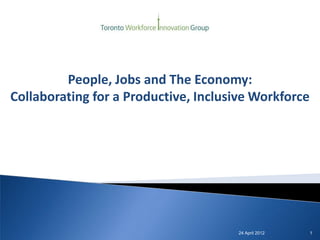
People jobs and the economy june 16-11[1]
- 1. People, Jobs and The Economy: Collaborating for a Productive, Inclusive Workforce 24 April 2012 1
- 2. 24 April 2012 2
- 3. 24 April 2012 3
- 4. Natural Disasters Shifting Demographics Knowledge Work Hourglass Economy Lack of Productivity and Innovation 24 April 2012 4
- 5. 24 April 2012 5
- 6. 24 April 2012 6
- 7. 24 April 2012 7
- 8. 24 April 2012 8
Notas del editor
- Workforce development focuses on ensuring that people are working by creating pathways and programs that bridge the current chasm between people and economic prosperity, social and economic development. Currently, in many instances, social development and economic development are defined separately and addressed through different and at times conflicting policy and programs. They are treated and, often, in opposition to each other, with people on one side and money on the other. Workforce development is the integration of both into one unified concept or strategy. Good workforce development or labour market planning asks these questions: "Does our community have the skill sets that businesses need?" and "Do we have the right infrastructure in place to support the businesses that want to be here? and Do our policies and programs combine social and economic development in ways that will grow our economy and utilize the skills and knowledge of our people?" Labour market stakeholders such as business, labour, government, education and training providers and workforce intermediaries working together can create a climate for economic growth and prosperity, supported by a skilled and knowledgeable workforce. There are many models to use for guidance and inspiration.Through workforce development, the growth of people, communities and societies becomes an integral part of economic growth. Without a well-educated, well-trained, satisfied and healthy population available to do the work necessary to develop business, the economy is unlikely to flourish in any sustainable manner. It’s about PEOPLE and JOBS
- Education systems (from preschool through to universities that not only support the growth of future generations but also the current workforce)Training systems (such as government funded Employment Ontario Centres and private institutions.)Government: HRSDC, MTCU, City, MCI, CICJob SeekersBusinessesUnions
- Matching the right people with the right jobs would be a lot easier if we knew exactly what the future holds. Unfortunately, we are not fortune tellers or prophets. If we were we’d be rich and maybe retired. At the same time, the future is not something that just happens to us; stakeholders involved in workforce development have a part to play in how that future will evolve. The choices and actions we all take now shape our future, for better or for worse. There are of course, things we can’t control such as the soaring price of energy, civil uprisings in the middle east, natural disasters around the world or floods in Manitoba. Still, all these events do impact on our economy and create circumstances we have to consider in our planning.And new government policies such as the Green Energy Act implemented in Ontario, shifting demographics in the population - with retiring baby-boomers, high levels of immigration bringing in global talent, and an increasingly educated young population, all have an impact on Toronto. As a part of our registration process, we surveyed participants regarding which trends are most affecting the need for skill development in their respective sectors in Toronto today. The trends participants told us were most important include: .overnment funding and policy decisions; Rising skills requirements for entry level jobs; Increasing skillls shortages in niche or emerging occupations ; Rapid technological advancements; Economic volatilityWe, the Toronto Workforce Innovation Group focused on some of these themes or issues in our 2011 Toronto’s Opportunities and Priorities report, which conveniently, is available this morning.
- It’s not enough to expect that people and jobs will simply match up without targeted efforts and systems in place to facilitate such match-ups. The question is, do our systems, institutions and alignments bring about the results we all hope for? How are we doing in terms of meeting the challenges, opportunities and tensions of a globalized and localized existence? Participants in attendance today are not very optimistic. More than 75% said that they do not feel that Toronto’s current education and training systems will be able to prepare a workforce capable of meeting the skills requirements and job demands of the future.
- Do all of us working and benefiting or not benefiting from workforce development in the GTA posses a common vision for what socio-economic development and prosperity should look like? Do we hold a common vision for what we would like our future in the city to look like? If we don’t have one, how will we know if we are succeeding in terms of creating a future workforce that has the skills and knowledge we’ll need? How will we know what changes need to be made in order to reach our goals? These are some of the questions we are posing to you the audience, as well as to our panelists today.
- Our role as the Toronto Workforce Innovation group is to convene discussions and events of this sort, to collaborate on workforce development projects and research. We want to facilitate a collaborative envisioning process amongst stakeholders that contributes to positive socio-economic development in the city. That’s the reason we’ve invited you to this morning’s event: “People, Jobs and the Economy: Collaboration for a Productive, Inclusive Workforce”. It is now my pleasure to introduce Allison Bramwell, our moderator.
- Thank you
